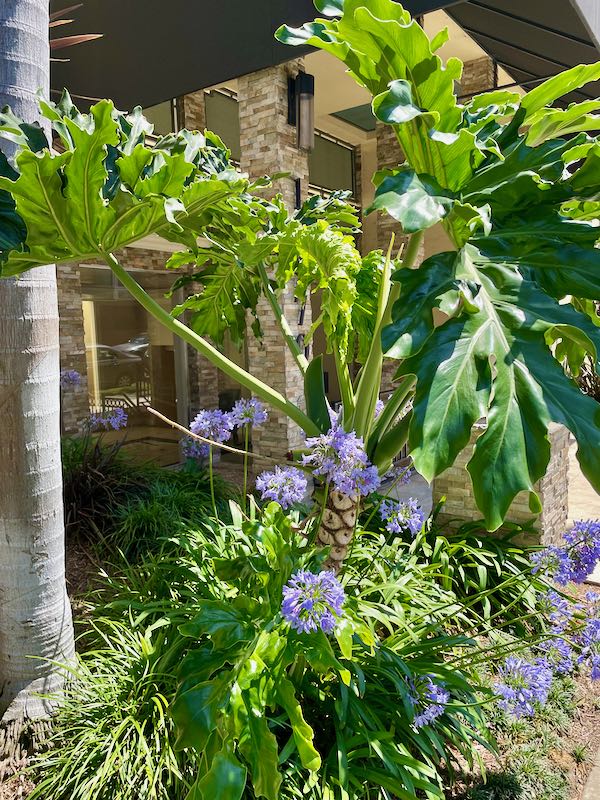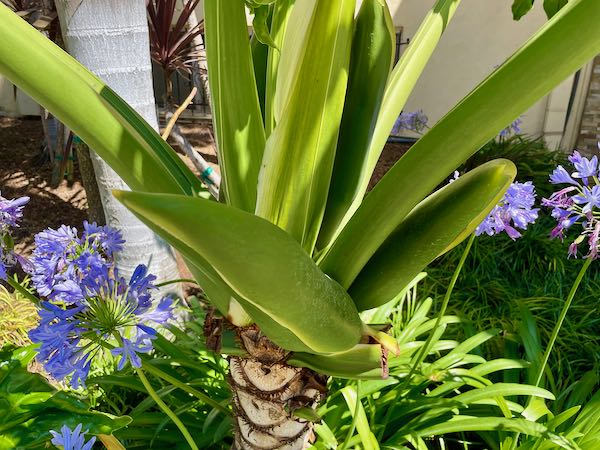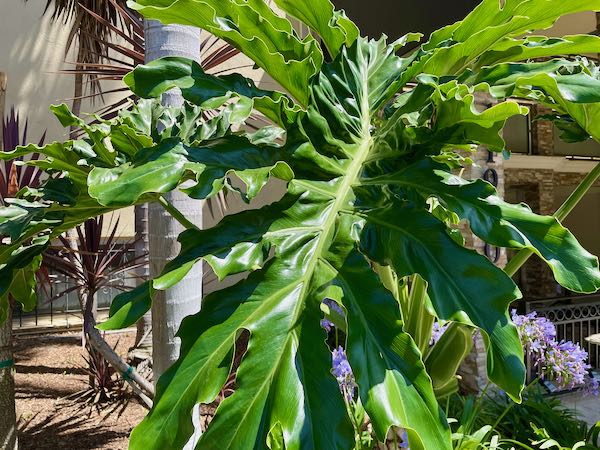Thaumatophyllum bipinnatifidum is a tropical plant, an evergreen shrub, from the Araceae family of plants. They previously placed this plant in the Philodendron genus. After recent DNA testing, they moved it to a new genus Thaumatophyllum. So Philodendron bipinnatifidum is a synonym.

It is native to South America, mainly to Brazil, Argentina, Bolivia, and Paraguay. You can plant Thaumatophyllum bipinnatifidum outdoors in temperate climates, such as Southern California. In cold weather, it will die down completely and regrow next season. They also call it the Lacy Tree, Philodendron selloum, Horsehead Philodendron, Fiddle-leaf Philodendron, or Panda Plant.
Thaumatophyllum bipinnatifidum can grow on its own trunk, however, If there is another support nearby it might show epiphytic characteristics and climb instead. The trunk produces aerial roots, that provide it with water and support. The height can reach 15ft or 5m. over time.
It has simple, large, deep green foliage. They are deeply lobed. The leaves can grow to 4ft or 1.2m long. The name “bipinnatifidum” is in reference to the leaf shape. The plant flowers after it matures. Sometimes taking about fifteen years before it flowers. It usually flowers in the summer.
The flower is white, without petals, and appears on a spadix. A spathe or a modified leaf protects the flowers. The spadix has three sections, with fertile male flowers a the end, sterile male flowers in the middle, and fertile female flowers toward the chamber. The flowers are fertilized by pollinators. Thaumatophyllum bipinnatifidum attracts pollinators by releasing a scent which is achieved by heat-producing sterile male flowers.

How to grow Thaumatophyllum bipinnatifidum:
Growing Thaumatophyllum bipinnatifidum: A Majestic Tropical Beauty
Sun and Light Requirements: Thaumatophyllum bipinnatifidum, commonly known as Split-Leaf Philodendron or Swiss Cheese Plant, thrives in bright, indirect light conditions. While it can tolerate some shade, providing it with ample sunlight will promote healthy growth and vibrant foliage. Place your Thaumatophyllum bipinnatifidum in a location where it can receive bright, filtered light, avoiding direct sunlight that can scorch its leaves.
Well-Drained and Moist Soil: When planting Thaumatophyllum bipinnatifidum, use a well-draining potting mix that retains moisture without becoming waterlogged. This tropical beauty prefers soil that is rich in organic matter and holds moisture while allowing excess water to drain away. Regular watering is essential to keep the soil consistently moist, but be cautious not to overwater, as it can lead to root rot.
Warm and Humid Environment: Thaumatophyllum bipinnatifidum thrives in warm and humid environments, mimicking its natural habitat in tropical regions. Maintain a temperature range of 65-80°F (18-27°C) to ensure optimal growth. Enhance humidity levels around the plant by misting its leaves with water or placing a tray filled with water near the plant, allowing for evaporation and creating a humid microclimate.
Supportive Structure and Pruning: As Thaumatophyllum bipinnatifidum grows, its large leaves and aerial roots may require support. Use stakes, trellises, or moss poles to help the plant maintain an upright and well-balanced form. Regular pruning is beneficial to control the plant’s size, remove damaged or yellowing leaves, and promote bushier growth. Prune with clean and sharp tools to prevent the spread of diseases.
Fertilization and Nutrient Needs: Thaumatophyllum bipinnatifidum benefits from regular feeding during the growing season. Apply a balanced, water-soluble fertilizer diluted to half strength every two to four weeks to provide essential nutrients. Avoid over-fertilizing, as it can lead to salt build-up in the soil. During the dormant season, reduce or suspend fertilization, allowing the plant to rest.
Pest and Disease Management: While Thaumatophyllum bipinnatifidum is generally resistant to pests, it may occasionally encounter issues such as spider mites or mealybugs. Regularly inspect the plant for signs of infestation, such as webbing or tiny pests on the leaves. If detected, treat the affected areas with an organic insecticidal soap or neem oil solution. Proper airflow and avoiding waterlogged conditions can help prevent fungal diseases.
Propagation and Repotting: Thaumatophyllum bipinnatifidum can be propagated through stem cuttings or air layering. Stem cuttings can be rooted in a well-draining potting mix with high humidity until they develop roots. Repotting is typically necessary when the plant outgrows its current container or when the soil becomes compacted. Choose a slightly larger pot and use a fresh potting mix to provide ample space and nutrients for continued growth.
With its magnificent, deeply lobed leaves, Thaumatophyllum bipinnatifidum brings a touch of tropical elegance to any indoor space. By providing it with the right balance of light, humidity, and care, you can cultivate a majestic plant that becomes a stunning focal point and a source of admiration for your home or office.




